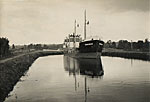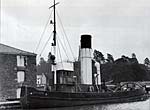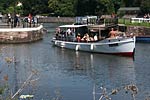
Ships and boats on Exeter's Canal
Page updated 14th September 2015
Back to Transport
Exeter's canal has been used by boats, lighters and ships since 1563. This page shows photos of some of the later shipping traffic on the canal. If you have a photo of a ship or boat on the canal that would add to the collection and would like to include it on this page, please contact me.
 The Canal Basin circa 1914
The Canal Basin circa 1914
A postcard dated from circa 1914 shows the canal basin from Kings Sluice. The tall chimney was part of the electricity generating station.
 Turf Locks between the wars
Turf Locks between the wars
A photo from a 1920s Exeter guide showing the basin for Turf Locks. A ketch is moored on the left, while a ship is in transit through the lock, in the distance.
 Horse towing a ship at Seages Bridge
Horse towing a ship at Seages Bridge
This inward bound ship, is shown being towed close to Seage's Bridge – the bridge was situated between the Salmon Pool Bridge and the basin.
 Entering the Double Locks
Entering the Double Locks
A three masted ship enters the Double Locks bound for the basin. The building on the left was the stables for the horses. The lock keepers house is now a popular pub and eatery.
 Moonlight over the canal
Moonlight over the canal
This postcard shows a horse drawing a ship along the canal. It dates from before the First World War when postcards of many subjects were sent much as modern email is used. Looking carefully at the photo, and taking into account the slow film speeds utilised at the time, I believe it to be a fake – it has been printed very dark to simulate a night scene.
 A busy Canal Basin
A busy Canal Basin
Even when the basin and canal were in decline due to the railways, coal, timber, fish, oil and other goods were shipped to Exeter by sea. Although slow, and uncertain, due to weather and tides, small coasting vessels were favoured for heavy goods from the north of England and Scandinavia. Ships from many nations could still be seen in the basin before the First War.
 Boating on the canal
Boating on the canal
Small rowing boats could be hired from a landing near Exe Bridge. Many would head for the canal, for within a short distance, the crowded quay and basin were left behind, and a pleasant trip along a rural canal could be made – ideal for a young man wearing his boater, to woo his young lady.
 Barge waiting at the Double Locks
Barge waiting at the Double Locks
A small barge appears to be waiting for the to leave the Double Locks through the lower gates.
 The schooner Abeja berthed at the quay below Colleton Hill
The schooner Abeja berthed at the quay below Colleton Hill
The schooner Abeja was photographed circa 1900 at the Port Royal quay. With a gross tonnage of 191 tons, and 103 ft in length was a frequent visitor to Exeter. Capable of crossing the Atlantic, she was mostly used for coastal trade. She was built in 1881 by J & W B Harvey at Littlehampton, Sussex. Her master was A Rowe, and the owners W & C Phillips. This part of the quay was often used for storing and transporting scrap.

 MV Esso Jersey
MV Esso Jersey
A frequent, visitor to the canal and basin was the Esso Jersey. She would deliver oil and petroleum to a small oil depot situated approximately were the apartments and Bar Venezia can now be found. Her last visit was in 1972. Photo left Alan H Mazonowicz and right, Dick Passmore.
 The Ben Johnson enters the Double Lock
The Ben Johnson enters the Double Lock
Photographed in 1955 at the Double Locks, the Ben Johnson was a small tanker that supplied the oil tanks at the basin. Photo courtesy Express and Echo.
 Swing bridge opened for the Satelith
Swing bridge opened for the Satelith
Named the Satelith, this visitor to Exeter was built by Danyard in Frederikshavn, Denmark in 1964. She was a general cargo ship of 678 gross tons. Here, the swing bridge at Countess Wear has been opened, and the road traffic stopped for her to pass. Photo courtesy Express and Echo.
 A ship glides past the traffic 1961 New
A ship glides past the traffic 1961 New
It must have seem strange to see an ocean going ship slide past the traffic, waiting at the barriers for the swing bridge. Photo © Michael T J Wride.
 New Ben Johnson passes the swing bridge
New Ben Johnson passes the swing bridge
This photograph was taken by George Monk sometime before 1948. It shows the Ben Johnson passing down the canal, past an open swing bridge at Countess Wear. Photo courtesy Reg Monk.
 MV Guidesman traverses the canal
MV Guidesman traverses the canal
The Regent Oil, MV Guidesman tanker, was a frequent visitor to Exeter from the 1950s to the 1970s, along with her her sister ship, the Tillerman. They would transport petroleum to Exeter, unloading at Regent's Wharf, just above Gabriel's Wharf. Photo courtesy Express and Echo.
 MV Guidesman enters Turf Lock
MV Guidesman enters Turf Lock
Here the Regent Oil petroleum tanker, MV Guidesman, enters Turf Locks.
 MV Wolanda unloading timber
MV Wolanda unloading timber
Constructed in 1935 in the Netherlands, the MV Wolanda was 233 tons and 35 metres long. Here she is photographed before 1972 unloading timber on the canal. Photo Groninger Kustvaart
 MV Tillerman breaks the ice
MV Tillerman breaks the ice
The MV Guidesman, was a frequent visitor to Exeter. She is shown outward bound as she passes Salmon Pool Bridge. She operated in the 1960s and 70s. Photo courtesy Express and Echo.
 MV Dapa unloading timber
MV Dapa unloading timber
The MV Dapa was a British motor vessel of 238 gross tons. Here she is at Gabriel's Wharf, in the canal. The MV Dapa was wrecked on the 10th February 1979 off Guadeloupe, in the West Indies. Photo © Porthole Productions.

 MV Jenjo unloading timber
MV Jenjo unloading timber
Two views of the Harlingen registered MV Jenjo at the timber wharf. She was the last commercial vessel to traverse the canal, apart from SW2 (Countess Wear). Photos © Porthole Productions.
 MV SW2 sewage sludge carrier
MV SW2 sewage sludge carrier
This is a rare photo of the last ship to regularly use the canal. She carried sewage sludge, which it dumped at sea. MV SW2 was launched on 29th January 1963 from the yard of John Bolson and Sons of Poole. As she was owned by Exeter City Council, a committee was formed to name her – after due deliberation, they came up with SW2, as the other sewage works vehicle, a blue Morris van, was named SW1. She entered service on 21th May and dropped her first 217 tons of sludge outside the 5 mile limit on the 27th May. When the works were handed over to South West Water, in 1974, she was renamed 'Countess Wear'. Photo Alan H Mazonowicz.

 MV Countess Wear sewage sludge carrier
MV Countess Wear sewage sludge carrier
The SW2 was renamed 'Countess Wear' in 1974. On the right, the sewage sludge carrier is moored up by Exeter's sewage works on the canal. She was classified for operation between Berry Head to Beer Head, at a maximum of 20 miles from shore. She made more than 5,000 voyages, carrying more than 1.8 million tons of sewage sludge, between April 1963 and 31st December 1998. Photo Alan H Mazonowicz. Left is a photo of Countess Wear on her first and only visit to the basin, in early 1999, when the Mayor visited her, after she left service. Photo © South West Water.

 MV Countess Wear passes Turf Lock
MV Countess Wear passes Turf Lock
Two interesting photos of the Countess Wear kindly supplied by South West Water. Left, she passes towards the sewage works through the Turf Locks (128 ft long), with inches to spare on each side. Right shows the Captain Ron Gardner, on the bridge. She originally had a crew of six, but later on, a crew of three were sufficient to operate her. The ship's length was 122 ft. breadth 24ft 6 in. and 11 ft draught. Displacement loaded was 580 tons, cargo capacity 350 tons or 75,000 gallons – her service speed was 9 knots. Photos © South West Water.
 Opening the Maritime Museum
Opening the Maritime Museum
In 1969, a collection of 23 boats and sailing craft belonging to Major David Goddard, were put on display, along with exhibits from other sources at a new Maritime Museum on Exeter quay and canal basin. The museum was opened on 27th June 1969 when Sir Alec Rose, who had single handedly sailed around the world was rowed up the canal by Exeter Sea Cadets, to the basin, to open the new exhibits to the public.
 The St Canute at the Maritime Museum
The St Canute at the Maritime Museum
A favourite of the Maritime Museum, the tug, St Canute was probably the largest exhibit. Photo courtesy Express and Echo.
 The replica of the Nonsuch on the canal
The replica of the Nonsuch on the canal
Built by HBC to celebrate the tercentenary of her voyage to Hudson Bay in 1668/9, this replica visited Exeter in 1969. She was shipped to Canada, to sail down the Atlantic Coast to the USA, then she sailed in the Great Lakes, before she finally sailed down the Pacific Coast. She was presented to Manitoba in Winnipeg, and now forms part of a museum. Photo courtesy Express and Echo.

 Maritime Museum
Maritime Museum
An Arab Pearling dhow moored in the basin, and right, the tug St Canute with other exhibits. The Maritime Museum closed in 1997 and most of the exhibits were moved to the World of Boats at Eyemouth in East Berwickshire. Both photos by Alan H Mazonowicz.
 Naval Harbour Supply vessel at Turf Lock
Naval Harbour Supply vessel at Turf Lock
The basin at Turf Locks no longer sees commercial craft waiting for the tide – now it is full of small pleasure craft and boats laid up for the winter. Although legally, a vessel should not be occupied, this former Naval Supply Vessel has a windmill for electricity, and appears to be lived on.
 Boats laid up at Turf Locks
Boats laid up at Turf Locks
These two were photographed, laid up on the west bank of Turf Locks. by Alan H Mazonowicz in the 1970s.
 Visitor to the canal
Visitor to the canal
The fleet tender Loyal Moderator was a visitor in June 1975 when it was photographed by Alan H Mazonowicz..

 Visitors to the canal
Visitors to the canal
Left is the TS Royalist during a visit to Exeter in the 1970s. Right is the Thames barge David Gestetner in August 1978. Both photos Alan H Mazonowicz..

 Southern Comfort and Kingsley
Southern Comfort and Kingsley
The Southern Comfort, left, was a well known vessel as it set out from the quay to sail to the Double Locks. The smaller replacement, Kingsley, is shown exiting Kings Arms Sluice as it enters the canal for the short trip to the Double Locks. Photo left by Sean Creech and right by David Cornforth.
│ Top of Page │